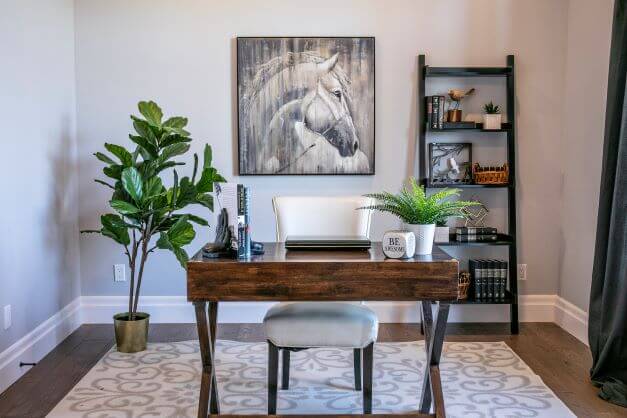The post Selling Home Staging in a Buyer’s Market appeared first on Styled, Listed, and Sold (SLS) Academy.
]]>
1. Emphasize the importance of first impressions
2. Highlight the return on investment
3. Demonstrate your expertise
4. Emphasize your understanding of buyer psychology
5. Be personable and professional and sell with integrity

Resources to help you get started
Styled, Listed, and Sold (SLS) Academy has all the resources you need to be successful as a home stager. Unlike other training programs and academies, we also focus on business skills — our comprehensive training has helped many of our students grow a profitable business from scratch.
Check out these great resources to build your skills and connect with your best clients
WEBINAR REPLAY: Mastering Branding – The Ultimate Guide to Building Your Brand
WEBINAR REPLAY: Attract Real Estate Agents
DIGITAL PRODUCT: Real Estate Partner Sales Booklet – turn your real estate agents into your sales team with this game-changing sales piece!
Home Staging Business Builders Training Center – Join a community of like-minded business builders
Not yet certified?
If you’re ready to take your passion for décor and turn it into a profitable staging business, sign up for our free home staging starter training. You’ll learn the insider secrets to building a successful staging career, from client acquisition to pricing strategies. Let’s take that passion and turn it into a career you’ll love!
The post Selling Home Staging in a Buyer’s Market appeared first on Styled, Listed, and Sold (SLS) Academy.
]]>The post How Much Does a Home Stager Make? | 2022 Industry Guide appeared first on Styled, Listed, and Sold (SLS) Academy.
]]>There are many paths to becoming a professional home stager and, yes, a career in home staging can provide you with a good stable income.
With the right tools in your pocket, you can start (and grow) your business quickly and efficiently. I’ve personally helped thousands of home stagers from all kinds of backgrounds and economic circumstances to become successful home stagers in their local area.
Here’s what you need to know about how much home stagers make, and how you can kickstart (or rejuvenate) a career as one!
What does a home stager do?
Home staging is the art of furnishing and decorating a home to make it aesthetically appealing to anyone walking through the front door. A professional stager typically works with real estate agents or home sellers to prepare and stage owner-occupied and vacant homes prior to listing their property for sale in their local real estate market.
Professional staging is not the same as interior design. Interior designers work with clients and create an environment based on their personal likes, dislikes, personal functional needs and preferred home look.
A home stager, in contrast, is trained to turn open houses into future homes that potential buyers find universally attractive. Selling a home is about marketing to today’s home buyers.
The day-to-day life of a home stager involves:
- Doing consultations with new clients.
- Planning room layouts and furnishings.
- Physically managing the movement and placement of ALL decor and furniture into vacant show houses.
- Advising clients on how to arrange their existing furniture and decor
- Helping clients clear clutter, clean surfaces and repair cosmetic defects
- And much, much more!
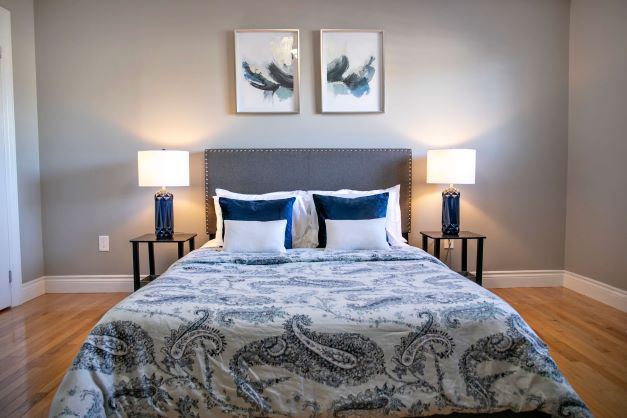
Home stagers often work to make small spaces appear bigger and more attractive to prospective buyers.
Why do people hire home stagers?
Home stagers position homes against their competition so that they stand out to and attract buyers. With more buyers interested in a home, the property will sell at a higher price — often 5-10% above the asking price. In most cases, it also helps the home sell after spending very little time on the market (1-2 weeks). If you think about a $500,000 home, a mere 5% increase in sale price net’s the seller an extra $25k! Considering the cost of staging, their return on investment is five times more than the cost of staging.
Three types of home stagers
While estate agents have governing bodies like the National Association of Realtors ® as well as state/provincial licensing boards, there’s no formal roadmap to becoming a home stager. In a self-regulated industry, the Real Estate Staging Association (RESA) provides standards and professional guidelines for members, however, membership is not mandatory to be a home stager.
As a home stager, your revenue is based on referrals from happy customers, partnerships with real estate agents, and the success of your marketing efforts within your area.
Here are the different ways you can run a home staging business.
Consultations-only
You help homeowners develop a DIY plan of action in your initial consultation. This business model doesn’t require much capital to start, but you will spend less time doing actual staging, and more time advising, planning, and building resources.
In-house
In-house stagers work for real estate agencies or home staging businesses. To find a full-time job in home staging, you need a portfolio of work, training, and experience. You may also start out as a staging assistant while learning the ropes.
Full-service business
A full-service home stager manages home staging projects from start to finish. They hold consultations, plan staging designs, arrange for furniture and decor to be moved or replaced, and physically set the stage of the house for prospective buyers. This type of business requires an inventory of furnishings that you rent to your clients or an agreement with a third-party furniture rental service.
Real estate agents are known to exclusively engage the services of a full-service home staging business.
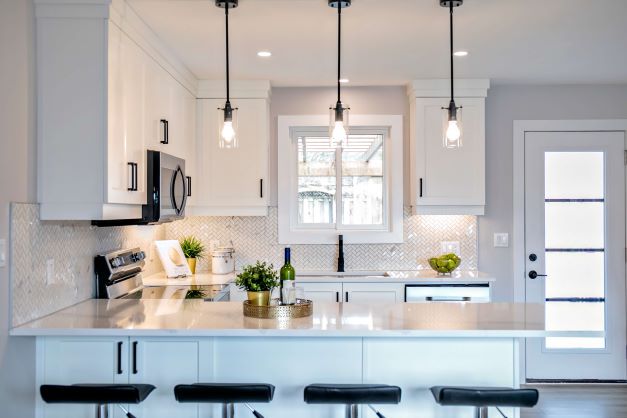
A professional home stager makes spaces aesthetically pleasing and creates a blank slate for the new owners.
How much money can you make staging homes?
Data supplied by ZipRecruiter indicates that most people working as a home stager will earn between $26,000 and $42,000 per year. The top 15% of home stagers earn between $48,000 and $81,000. (Note: The average salary of a home stager works out to be around $48,000, thanks to these outliers.)
If you are running your own home staging business, you will likely bill a rate of anywhere from $100-$200 per billable hour. Alternatively, if you opt to own inventory, you would also make a rental fee on items you use in a staged home. If you choose to work for a home staging company, your pay rate will depend greatly on your role and responsibilities within their company, however, you can expect to make an hourly rate between $15-$50.
But stats without context don’t really give you the full picture.
Let’s dive into what your monthly income might look like as a solo business owner.
Consultation fees on average cost +/- $300. This covers a couple of hours in which you assess the current state of the house, the number of rooms you need to stage, what the future home will look like, and the amount of work required. This consultation usually includes an upsell tailored to the client with one of the following solutions:
- Complete staging in each room with your inventory.
- Affordable staging with their EXISTING household items.
- A hybrid solution, such as staging key rooms only like the living room and master bedroom only, or providing a mix of your inventory with their existing items.
Each room staged with your inventory can be charged at an industry cost of roughly $500 per month. (It’s possible to charge much higher prices and furniture rental fees to clients if you work with luxury homes.)
Based on these numbers, the following monthly scenario could be what a 1-person business brings in every month:
- 6 x Consultations: $2,400.
- 2 x medium-sized staged homes for one month: $4,000.
- 2 x service-only stagings to stage the house with existing items: $1,000.
And that works out to a monthly gross revenue of $7,400. Next, you need to factor in your expenses to know how much you actually take home.
Understanding your local market
Different locations will allow you to charge varying fees. For example, stagers in New York and Los Angeles will charge a premium for their services due to increased expenses, cost of living, and luxury expectations. On the other end of the spectrum, stagers in a small town an hour outside of Ohio may find that their market won’t bare the same prices and may need to price their service fees far lower.
Factoring in your expenses
While most people will be happy to throw big salary numbers at you, they neglect to mention the costs of securing that revenue. I’ve noticed many people feel overwhelmed by the idea of expenses and operating costs, but it’s all part of running a business. And once you understand your expenses, setting goals and following budgets is as easy as pie.
When creating your business plan, think about the additional cost to do the following:
- The purchase or rental costs of your inventory.
- Training and certification in home staging and business skills.
- Your finance and administration costs (e.g., a bookkeeper).
- Movers, trucks, and storage fees.
- Mobile phone and internet costs.
- Marketing costs (such as a website developer, social media manager, and even Google ads).
- General office supplies.
There are some clever ways to manage and curb your expenses while you’re growing your home staging business. Here are a few great options:
Option 1: Go all-in at the start
This is the method I personally chose. Because I purchased the bulk of Beyond the Stage’s furniture and decor upfront, I expected to run at a loss for a whole five years (home staging was an extremely new concept in my market at the time). In reality, that panned out slightly better, and it took just a little more than three years for us to become a profitable business. And boy was it worth it! I have enough inventory to stage several houses at any one time, and I was quickly becoming the go-to in my area.
This option is entirely possible, but it will take some upfront investment — so you need to go in with a clear plan for not only operating the business but paying your personal expenses (i.e. do you have savings, spousal support, or a second job that could assist in covering costs while you build the business?).
Option 2: Start slow with consults and furniture rentals
Instead of purchasing your large inventory off the bat, keep costs low and rent them from furniture rental companies. Running a consults-only business avoids the expense of moving furniture in and out of houses entirely. Recently, virtual consults have helped stagers reach an even larger market while keeping their running costs at an all-time low. If you wish to provide inventory to clients, invest in the small goods only and leave the big stuff to a furniture rental company to provide. Alternatively, you can assist your clients with shopping for the staging items they need, and since they purchase the items themselves, they get to keep them in the next house!
Option 3: Become a home staging assistant
This has a little less of the glory, but provides a close-up look at the ins and outs of a home staging business, without the upfront investment. You will help a home stager assemble furniture, clean surfaces, make and steam beds, arrange movers, and more. If you feel nervous about entering the industry, it’s a great foot in the door. I’ve trained many assistants over the years and have found it’s crucial to have some training before you start.
Home staging tips for people looking to enter the industry
- Passion for home decor is a must!
On those days where you need to put yourself out there and give that little push to get yourself on the right trajectory… it’s passion that will keep you going. - Build systems from day one.
It all comes down to the systems you create. If you have a strategy for virtual staging consults, traditional homes, and empty homes, you can free yourself from repetitive admin work and focus on getting new clients. - Get clear on your target clients from the start.
Home staging is still a people game. Understanding where your clients will come from, and how best to interact with them, will be your secret to success. - Invest in professional photography.
This is your biggest sales tool and poor quality photos (no matter how great your smartphone camera is) could turn off clients before they’ve even contacted you.
Resources to help you get started
Styled, Listed, and Sold (SLS) Academy has all the resources you need to start a career in home staging. Unlike other training programs and academies, we also focus on business skills — our comprehensive training has helped many of our students grow a profitable business from scratch.
If you’re ready to take your passion for décor and turn it into a profitable staging business, sign up for our free home staging starter training. You’ll learn the insider secrets to building a successful staging career, from client acquisition to pricing strategies. Let’s take that passion and turn it into a career you’ll love!
The post How Much Does a Home Stager Make? | 2022 Industry Guide appeared first on Styled, Listed, and Sold (SLS) Academy.
]]>The post How to Become a Home Stager Without Breaking the Bank appeared first on Styled, Listed, and Sold (SLS) Academy.
]]>Unsurprisingly, demand for home stagers is through the roof and projected to keep climbing. But for many would-be stagers, the prospect of getting started in the business can be intimidating. The costs of buying and storing inventory can be especially worrisome.
But how expensive is it to become a home stager really? Here are the facts.
Is Inventory Essential for a Home Stager?
Inventory can be a double-edged sword. As home stagers, we can get endless use out of the perfect piece. Having a collection of versatile pieces on hand can also make it quick and easy to add some style and texture to common spaces like seating areas and foyers.
On the other hand, inventory is an investment. It takes time and money to acquire it in the first place, and then more time and money to transport, store, maintain, and manage it over time.
Inventory can be especially difficult for new home stagers. No new small business owner wants to spend a chunk of their salary buying up and managing inventory. Many new stagers also need time to dial in their target market, the demands of their region, and other details before they can commit to investing in a storage facility and the staging items to fill it.
What too many of us forget is that we don’t need inventory to be a great home stager.
In fact, non-inventory business models can be more than just a thrifty way to get started in staging without breaking the bank. Done well, they can be powerful marketing and growth tools!
If you are interested in how to become a home stager, there are three great models you can use that do not require an investment in inventory.
- Consulting-only staging
- Client-funded staging
- Hybrid-source staging
Consulting-Only Staging
In a consulting-only staging model, we as stagers help clients present their homes at their best using only items the clients already own. This model can hold tremendous appeal for both us and our clients.
It offers us:
- Freedom from the costs and hassles of buying and managing inventory
- A fresh challenge with each home
- A chance to show our creativity in unique ways with each client
- An excellent marketing pitch
For our clients, this method often appeals because:
- They do not have to worry about or work their lives and schedules around rented items during the selling process
- They do not have to put as much of their stuff in storage as they otherwise might
- It keeps their costs to a minimum
- It shows them new, creative, and attractive ways to use or display their belongings that they can carry with them to their new homes
This method may also strongly appeal to clients’ personal beliefs in minimalism, simplicity, frugality, or eco-friendly living because it gets the job done with minimum “stuff” and fuss.
Client-Funded Staging
For those among us in the staging community who like to shop, client-funded staging can be a delight. We evaluate how to stage a home for sale, buy the perfect items using clients’ money, and then allow the clients to keep the items at the time of sale.
For us, this:
- Prevents the accumulation of inventory
- Ensures we can select the perfect pieces every time
- Keeps business costs low
For our clients, this:
- Provides personalized staging results
- Makes it easy to see exactly where every dime of their investment goes
- Results in beautiful spaces that they can pick up and take with them to their next homes
Under this model, clients often feel like they get home staging and interior design services all in one. This creates value that rolls forward and gives them the feeling of getting extra bang for their bucks.
The Magic of Rental Companies
Another option for how to stage a home with little or no inventory and minimal costs is to become a master of using rental companies for your large staging furnishings. Essentially, this gives stagers access to fantastic inventory without the costs and hassles of buying and maintaining that inventory themselves.
It may take a little more legwork to arrange delivery and pickup of items between the client and rental company, but the benefits often more than outweigh that minor inconvenience.
Supplementing With Small Items
Some stagers supplement the “use a rental company” model with a small personal inventory of favorite items or pieces that fit the hottest new trends. This allows us to keep versatile odds and ends that we always seem to need on hand without a huge investment on our part.
Staying Flexible
One of the most ideal things about low inventory and hybrid staging models is how flexible they are. If we as stagers find that these models are a perfect fit for our businesses and markets, we can use them indefinitely.
Or, if we prefer, we can use them as jumping-off points until we are more established and have a clearer idea of what inventory pieces will serve us best. Then we can transition to other inventory models that serve us better as our businesses grow and expand.
Mastering Low or No Inventory Staging
Choosing the right home staging course is the first step to mastering the art of running a low-inventory or no-inventory staging business.
We know that launching a new career can be stressful and confusing, so our home stager certification training course takes the guesswork out of every step. We walk new stagers through:
- The behind-the-scenes secrets of how the home staging industry works
- How to competitively price staging services
- How to write client contracts and handle client communications
- The best staging techniques for every space
- How to establish the policies and practices that make a business thrive
- Portfolio building
- The biggest mistakes new stagers make and how to avoid them
- How to start a business without a big financial investment
Unlike many other courses, our course also sets you up for success by providing you with the essential tools you’ll need to get started right away. These include, but are not limited to:
- Reference materials you can use on-the-job
- A color wheel
- An architect’s ruler
- Our Consult Toolkit
- A Sherwin-Williams Fan Deck
No matter what type of low-inventory or hybrid staging model appeals to you, we have the tools and knowledge you need to make it work.
Ready to Get Started as a Home Stager?
If you’re ready to take your passion for décor and turn it into a profitable staging business, sign up for our free home staging starter training. You’ll learn the insider secrets to building a successful staging career, from client acquisition to pricing strategies. Let’s take that passion and turn it into a career you’ll love!
The post How to Become a Home Stager Without Breaking the Bank appeared first on Styled, Listed, and Sold (SLS) Academy.
]]>If you are considering home staging as a career, you might be underwhelmed by the amount of information about how to get started. While some colleges offer some basic courses on home staging, it can be difficult to figure out where to get your training, and whether or not it’s even something that you need.
If you are planning to offer home staging services, it is recommended that you enroll in a reputable home staging certification training program. Here’s the skinny on this – home staging is NOT a regulated industry, therefore, you are not required to receive any licensing, diploma, or certificate in order to call yourself a home stager. In fact, you can wake up tomorrow, call yourself a home stager, and *poof*, you’re a home stager.
Right…?
WRONG
Now that you’re calling yourself a home stager, what exactly makes you a home-selling expert? Why should people hire you? Why should your clients take your advice?
Sure, there are some great online resources available today that will provide you with some general information about staging a property for sale, but to become a qualified and successful home stager, you want to be sure to arm yourself with the best resources. Who do you trust with your money? Do you have a financial advisor, or an accountant? I’m sure that they have likely received some pretty extensive training; after all, you are trusting them with your money. What about your doctor, they received some training as well, didn’t they? I mean, you are trusting them with your life. When working with homeowners to sell their home, you are working with their largest asset, and they are trusting you to do great work – this means selling their home in the shortest timeframe possible, for the most amount of money.
You might be thinking that you have “staged” and sold many of your own homes already, and your friends have probably told you that you should pursue a creative career because of your natural eye for design, and this is certainly a valuable skill when it comes to becoming a home stager, but it isn’t the only skill needed.
Did you know?
Home staging is just as much about marketing, as it is about decorating.
Home staging is about properly merchandizing and marketing a property for sale. Even if you have received formal training to become an interior designer or interior decorator, you will find great value in taking a home stager certification course. While many concepts of the two industries overlap and inspire each other, home staging is a part of the real estate industry, and operates with very different guidelines, processes, and “rules” (whether official or not) – your home staging certification will teach you which design elements to use and when. Setting up a home for sale takes a lot more than a little cleaning and decluttering. Here are just a few things that your certification training program should outline and teach you:
- The ins and outs of the Real Estate Market, the key players and how home staging fits in
- The various business structures, creating your business plan, and registering your new home staging business
- Creating your staging plan by addressing buyer perceptions, decluttering, and eliminating distractions
- Furniture selection and placement for optimal flow and buyer appeal
- Step by step review of the home staging evaluation – what to look for, and what to address with your home sellers
- Accessorizing techniques for selling
- What role textures and fabrics play in home staging and design
- Organizing spaces for selling and living
- Repairs and updates – what to address and how to understand the value and impact of each recommendation
- Creating curb appeal and lasting first impressions
- Identifying design styles and working within them
- Creating and preparing accurate floor plans
- Colour theory – using the colour wheel as a tool in colour palette selection; understanding the components and significance of colours
- Preparing your home sellers for the process of selling their home, including managing seller expectations and resistance
- The home staging consultation, from start to finish
- The people factor – the importance of working with the homeowner throughout the process, and understanding their needs
- Managing your owner-occupied and vacant home staging projects, start to finish
- Building your portfolio (especially when you are first starting out)
- How to set up your office to run efficiently and effectively to keep you out meeting with clients and building the business
- Contracts – what clauses to include, policies to consider, and how to create these to ensure that they are ironclad
- How to work with subcontractors
- Health & Safety, and how it applies to your home staging business
- Insurance – what you need, to ensure that you are properly covered
- How to set your policies and procedures for smooth operating practices
- Inventory management and best practices (applies regardless of whether or not you choose to own large furniture pieces)
- How to outline your services and set your pricing (including identifying the various services that you can offer to help your clients, such as color consultations, shopping, decluttering, organizing, project management, and more)
In addition to teaching you how to run your home staging projects, a quality home staging certification program will provide you with the tools and templates that you need to be successful – this is invaluable! I can’t even begin to explain the amount of time that this alone will save you when you are first starting your business. Why re-invent the wheel? From outlining what your services will include, how to provide each service, pricing your services (to get paid your value as an expert in your field), plus contracts, insurance, and SO MUCH MORE! Mistakes can be very costly, so arm yourself with the tools and the information to safeguard yourself, and your business.
Becoming certified as a home stager will also add to your credibility. Keep in mind that the very real estate agents that you will be working with are required to take an intensive training course before working in the industry, and they are also required to earn additional credits through continuing education courses throughout the year, in order to maintain their license. They expect that the people that they work with as a part of their home-selling team are just as qualified, and have invested a similar amount of time, money, and energy.
Above all else, in taking a home staging certification course, you receive the thrill of learning something new, and I promise, you will learn something new. For more about how to choose the right home stager certification training program for you, check out our blog here.
Ready to Get Started?
If you’re ready to take your passion for décor and turn it into a profitable staging business, sign up for our free home staging starter training. You’ll learn the insider secrets to building a successful staging career, from client acquisition to pricing strategies. Let’s take that passion and turn it into a career you’ll love!
The post Do I Need to be Certified to Work as a Home Stager? appeared first on Styled, Listed, and Sold (SLS) Academy.
]]>The post How to Get Started as a Home Stager appeared first on Styled, Listed, and Sold (SLS) Academy.
]]>Do your research
Just like any career, you want to be sure that you know what you’re getting yourself into! Don’t be fooled into thinking that what you see on TV is the full picture. So how do you learn more about the industry?
- Reach out to local home stagers – the best way to do this is to find out if there is a local RESA chapter nearby where you could attend a meeting. Home Stagers, like most entrepreneurs, work very hectic schedules, and given that they are working in the real estate industry, most of their work is very time-sensitive. While most love to help to educate others about what a career in home staging is all about, they may not always have the time to meet or chat with you. That said, if you do not have a local RESA chapter in your area, absolutely feel free to reach out to home stagers directly, keeping in mind that you are more likely to receive a response during a time of year when the real estate market is a little slower (this can vary by city, and in some areas, simply doesn’t exist).
- What is the local demand for home staging services? Home staging has been a VERY lucrative and rewarding career choice for a lot of people, but keep in mind that some real estate markets will be much more advanced in their home staging awareness and adoption of this service into standard industry practice. A successful home staging business can be built anywhere, but if the home staging industry is less developed, some areas may take longer to build, and you will want to be prepared for this. In addition to speaking with home stagers, it would serve you well to talk to real estate agents, mortgage brokers, and others in the real estate industry to help you to gauge the demand of your services.
- Job Shadowing – this is a great opportunity to get to see what home staging is like, first-hand. I once had a staging assistant who had a great interest in potentially becoming a home stager herself, and welcomed the opportunity to get a first-hand look at the industry by working alongside me. After only two home staging projects, she quit. She said that she “just wanted to be a home stager”, and if I had any work that was more or less “just staging”, then she would be happy to help. What she failed to realize was that every aspect of work that was assigned to her, in fact, WAS home staging! She wanted a real look at the industry, and we gave it to her, but it turns out that she really only wanted to work in the TV version of what she thought home staging was. Job Shadowing a local stager is a great way to see exactly what a career in home staging looks like.
- Join a Facebook Group – we happen to have created one geared at people just like you! Click here to join the group and ask any questions that you would like!
- Strategy Session – Are you someone that would just prefer to talk it out? Click here to book a one-on-one with me, where you can ask me anything!
Budget for Your New Career
What costs should you expect when first starting your business? What will your on-going operating expenses be like? How will you pay your bills while you are building your business? Will you own your home staging inventory, or rent from a third-party furniture rental company?
There are a number of questions like this that you will want to explore BEFORE diving head-first into the deep end. We answer all of these questions and more in our Behind-the-Scenes webinar.
Get Professional Training
Just like any profession, proper certification and training is critical to success. The investment in a quality certification program is just like the one that you would make to become an accountant, a plumber, or any other skilled profession. While you may have a natural talent that will serve you very well in this industry, it’s your training that will make you an expert in your profession, one that your clients will be happy to pay for.
Create a business plan
“A goal without a plan is just a wish.”
― Antoine de Saint-Exupéry
Once you have been trained as an expert in your field, it’s time to get yourself out there and start generating some business! To do this, you will need to select a business name, what type of business you will operate (sole proprietor, partnership, corporation, etc), and set out your company’s policies and objectives. All of this and more should be covered in a detailed business plan – do NOT skip this step! Remember:
“By failing to prepare, you are preparing to fail.”
― Benjamin Franklin
Read my book (warning…shameless plug)
Oh yeah…did I mention I’m writing a book all about the ins and outs of becoming a home stager, and what you can expect as you embark on this career? Well, it’s not ready just yet, but you can check out an excerpt from it here, and we hope to open pre-sales for the book VERY soon!
To download our FREE Guide to Getting Started as a Home Stager, click here.
Still have questions about getting started as a home stager? Schedule a 1-on-1 chat with home staging expert, Shauna Lynn Simon – click here to select a time that is convenient to you.
Ready to Get Started?
If you’re ready to take your passion for décor and turn it into a profitable staging business, sign up for our free home staging starter training. You’ll learn the insider secrets to building a successful staging career, from client acquisition to pricing strategies. Let’s take that passion and turn it into a career you’ll love!
The post How to Get Started as a Home Stager appeared first on Styled, Listed, and Sold (SLS) Academy.
]]>The post Selling Home Staging in a “Seller’s Market” appeared first on Styled, Listed, and Sold (SLS) Academy.
]]>What is a seller’s market? A seller’s market simply means that there are fewer homes for sale with a large number of buyers looking to purchase. This offers a great advantage to home sellers as this can drive housing prices up, and most house are sold with multiple offers. Buyers will be quick to move on a property that they are interested in, and will work to present the most appealing offer possible in an effort to secure the property. This can be a game-changer for almost any real estate market.
Here is where you come in as a home stager – in a seller’s market, homebuyers are often purchasing at the top of their purchasing power. This means that most buyers will have very little funds available, if any, to spend on any additional renovations or repairs upon purchase of the home and therefore the importance of a move-in ready home is higher than ever. Homes that are prepared properly will net the greatest return and largest quantity of offers.
Regardless of the market, most buyers have one thing in common – they do not have the time, nor the desire to perform work on a new house, and thanks to popular television shows, a buyer’s expectations of a move-in ready home have never been greater.
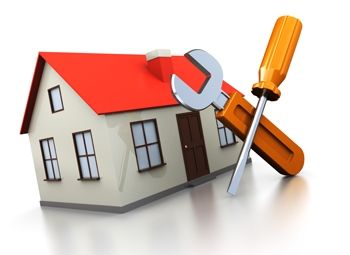
In a seller’s market, home staging is the ultimate marketing tool! Home Staging could mean the difference between an offer and a bidding. When selling homeowners and/or real estate agents on your services in a seller’s market, focus on where you add value:
- A professionally trained home stager can help to identify hidden value in your home. Home Staging utilizes merchandising techniques to showcase the best features of the home.
- The goal of home staging is to clearly define the space, show proper scale, and create an emotional connection for buyers – this results is higher quality offers and is achieved through the necessary updates and repairs, proper furnishing, arranging, accessorizing, and essentially, merchandising of the space.
- A home stager can help to identify the most cost-effective updates/repairs to address to help to avoid buyer uncertainty and allow the home sellers to skip any unnecessary expenses.
- Working as a part of your home-selling team, a professional home stager will provide practical and creative solutions for showcasing your home.
Emphasize to the real estate agents that you are a part of their team! The biggest pain point for a real estate agent in a seller’s market is securing listings. Homeowners know that their houses will sell, so they are choosing agents based on who provides them with the greatest value, and who can get them the most money for their home. Home staging is the best marketing tool that an agent can use – you could be the difference between an offer and a bidding war! Savvy agents will choose to present an effective home-selling team to secure their listings. In fact, there has never been a better time to invest in home staging – every homeowner is guaranteed to benefit from your expertise! You can return their support of your business by emphasizing what a great agent they are to work with to the homeowners. By working with you and offering your services, the agent will gain more listings, and in-turn, more referrals. It’s a win-win!
Have questions about becoming a Home Stager, or just starting out and need an extra boost in your business? Join our Facebook group, To Be a Home Stager – our very own Shauna Lynn Simon is live online every Thursday afternoon, answering your most pressing questions!
The post Selling Home Staging in a “Seller’s Market” appeared first on Styled, Listed, and Sold (SLS) Academy.
]]>Free Guide Provides 7 Steps to Getting Started as a Home Stager!
7 Steps to Get Started in a
Career in Home Staging!
Download this FREE Cheat Sheet to get started
- CNN named home staging as an industry poised for growth!
- 81% of buyers say home staging makes it easier to visualize the property as their future home (NAR)
- Staged homes spend 90% less time on the market (RESA)
- Home Staging is an effective sales technique that integrates decorating with marketing and creates an experience for buyers
Start your journey to becoming a home stager
- Take control of your future as an independent business owner
- Put your creative skills to use helping others
- Gain financial independence
- Enjoy a fast-paced and exciting industry
Get Started Today!
“I really enjoyed taking this course. It is full of detailed information regarding all aspects of home staging from the basic “what is home staging?” to wall art hanging heights and what to look for in a home. I appreciate all the time and effort that went into the content of this course as well as all the downloads and personalized templates. I highly recommend it for anyone that is interested in home staging. I feel that I learned way more information than I originally thought would be included in the course and I completed it feeling confident in my knowledge and what was presented. The value for what you get it incredible.”
“I enjoyed everything that I learned and Shauna Lynn, I think you are very confident and a great instructor. Thank you again for all of the knowledgeable information.”
“Attending SLS Academy was one of the best things I did for myself! Not only did I gain valuable information and the tools to become a successful stager, but it has given me the confidence to follow my passion. Thank you, Shauna Lynn, you have been such an inspiration!”
The post 7 Steps to Get Started in a Career in Home Staging! appeared first on Styled, Listed, and Sold (SLS) Academy.
]]>The post How to Choose the Right Home Staging Course for YOU appeared first on Styled, Listed, and Sold (SLS) Academy.
]]>You’ll notice that price was not mentioned as a factor here, but in truth it should be mentioned. The reason that it was not outlined as a deciding factor is that most reputable training programs will be comparable in price, and therefore this shouldn’t be a deciding factor. If a program is listed significantly lower than the others that you have researched, the chances are that the training provided will be sub-par (you’ve heard the saying that “you get what you pay for”, right?).
The post How to Choose the Right Home Staging Course for YOU appeared first on Styled, Listed, and Sold (SLS) Academy.
]]>The post Why Interior Designers Make Great Home Stagers appeared first on Styled, Listed, and Sold (SLS) Academy.
]]>I have met a number of home stagers over the years that began in the field of design, only to realize that their true passion was for home staging. That said, don’t be misled – while these two industries share a number of similar traits, there are just as many fundamental differences:
Let’s do a comparison:
As a Designer:
You work with a client’s overall style to create your design plan, based on their specific likes and dislikes.
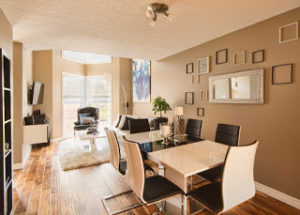
As a Home Stager:
You work with a home’s overall style to create your staging plan, based on the neighbourhood, house characteristics, and buyer demographics. Your aim is to appeal to the largest variety of buyers possible.
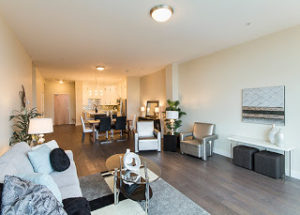
As a Designer:
Projects can take several months to complete.
As a Home Stager:
Most projects are completed in less than a month from consult to completion, and in some cases they can be completed in just one week! Be warned – this instant gratification can be addicting.
As a Designer:
More is better!
As a Home Stager:
Less is more!
As a Designer:
The elements used to create a room are often a large part of the central focus of that room, including all furnishings and statement pieces, as well as the accessories and artwork throughout.
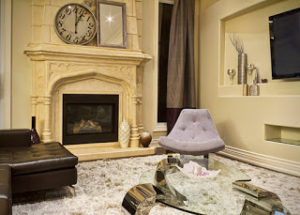
As a Home Stager:
Ideally, in home staging, you want to eliminate anything that could be considered a distraction in order to place the focus on the appealing selling features of the house. For this reason, statement pieces are often avoided in favour of more neutral selections.
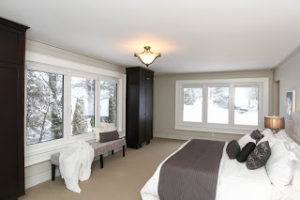
As a Designer:
The goal of a project is to provide an attractive and functional space.
As a Home Stager:
The goal is to sell the house – therefore you are merchandising the home in order to effectively market it. While function should play a role, some comfort of living is often sacrificed to create the best overall look and feel.
As a Designer:
Personal elements help to create a comfortable home for the owners.
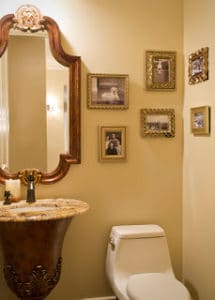
As a Home Stager:
Personal items are removed in order to eliminate this potential distraction. Buyers want to envision themselves in the space, and an overly personalized space can make this challenging.
Where Home Staging and Design overlap:
- Proper furniture placement is critical to a successful plan. In home staging, standard placement rules apply as they would in design – in fact, in home staging, you’re often outlining for buyers the ideal position of items throughout the space.
- Room flow is especially important when selling a home. Just as it can affect the comfort of a room for living, improper flow can easily turn off buyers without them even realizing it! The flow of a space can affect buyers on a sub-conscious level, and prevent them from placing an offer on the property.
- Current trends are applied to both design and home staging plans. In home staging, these trends should be applied in the decorating aspect, and avoided in more permanent elements and fixtures.
- A well thought out and cohesive plan will always create a warm and inviting space.
While there are many stylists that will cross over both industries, and enjoy the challenges that each brings, there are others that prefer to work in their creative niche and comfort zone. The diversity of offering both services can help to keep your designs fresh and fluid! Home Staging is a great complimentary service for design professionals, putting their natural talent to work with a quick turn-around and outcome. Let’s face it – eventually, design clients will sell their house, and that allows designers to easily turn these same clients into home staging clients. Whatever you choose, if you are passionate about what you do, you’ll find your way.
Interested in learning more about home staging? Check out Talent vs Training to see what your certification program should provide, and why formal training is critical to success in the home staging world, regardless of a design background.
The post Why Interior Designers Make Great Home Stagers appeared first on Styled, Listed, and Sold (SLS) Academy.
]]>The post Talent vs Training – Which Matters More? appeared first on Styled, Listed, and Sold (SLS) Academy.
]]>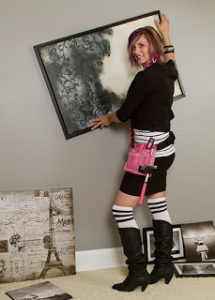
What should you expect from your home stager training?
- How to run a business
- How to manage your clients
- Insights into buyer AND seller behaviours
- How to merchandise a home to make it a sellable product that your buyers will want to buy
- How to “sell” – sell the house, sell potential clients on your services, and sell your home sellers on your recommendations (what good is it if you know what they need to do, if you can’t convince them to make the changes necessary?)
- Home styling trends and styling tricks
- Post-training support to help you to successfully launch your business
- Current and up-to-date information regarding industry standards, trends, and expectations

The post Talent vs Training – Which Matters More? appeared first on Styled, Listed, and Sold (SLS) Academy.
]]>